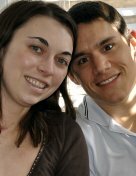234 Goodman Street, Cincinnati, Ohio 45219 | (866) 941-UCNI (8264)
Cerebrovascular Center
Dick's Story: Ischemic Stroke

As a firefighter who attends regular EMS drills, Dick Koeniger was well versed in the signs and symptoms of stroke. While driving home with a friend one evening last June, he suddenly noticed that his peripheral vision was slightly impaired. Odd, he thought. Was it related to the tension headaches, right behind the eyes, that he had suffered while working as a high school teacher and principal? He continued driving. After arriving home about 20 minutes later, he realized that he had a slight loss of motor control with his left hand. “It was very slight, but as it began to progress you notice – holy buckets! What’s going on?” Mr. Koeniger recalled. “I added one plus one and thought, guess what: I’m having a stroke.”
Under normal circumstances, the rule for stroke is to call 9-1-1 immediately so that treatment can be given in time to be effective. But Mr. Koeniger was at home in rural Indiana, and he knew that summoning his local emergency response unit for an initial assessment and then waiting for a helicopter to transport him to a primary stroke center would eat up valuable time. He made his decision: He told his friend to drive him to University Hospital in Cincinnati, home of the UC Neuroscience Institute. Though the trip would take 40 minutes, Mr. Koeniger reasoned that he would arrive within the window of time when stroke treatment could help maximize his chances of avoiding long-term disability.
When he pulled into the emergency department at 8:50 p.m., Mr. Koeniger was met by someone he knew well. Donald Locasto, MD, an emergency medicine physician, recognized him from EMS training and asked, “Dick, what are you doing here?”
Mr. Koeniger replied, “Don, I think I'm having a stroke.”
"OK, he's having a stroke,” Dr. Locasto exclaimed. “Let's go!"
In a rapid-fire sequence that showcased the best in healthcare at a primary stroke center, physicians examined Mr. Koeniger carefully and performed a brain scan, which revealed that a blood clot had lodged in a blood vessel just above and behind his right ear. Laura Heitsch, MD, a stroke team member summoned from home, administered tPA, a drug that would dissolve the clot, less than 90 minutes after Mr. Koeniger’s arrival and just over 4 hours after his stroke was presumed to have begun.
“He was past the three-hour window that is considered ideal,” Dr. Heitsch said. “But he was still within the larger, four-and-a-half-hour window of effectiveness that is now considered appropriate for some patients.”
Mr. Koeniger spent two nights in the Neuroscience Intensive Care Unit at University Hospital and was then discharged, his vision problems and diminished left-hand capacity restored. Ever grateful – “They brought their ‘A’ game!” – he is back working full throttle for the Colerain Township Fire Department.
Stroke Team in action
20:50 Mr. Koeniger arrives at UH
20:53 CT scan is performed
20:54 Dr. Heitsch is summoned from home
21:17 Dr. Heitsch arrives at bedside
21:38 Dr. Heitsch administers tPA
* * *
Hope Story Disclaimer – This story describes an individual patient’s experience.
Because every person is unique, individual patients may respond to treatment in different ways. Outcomes are influenced by many factors and may vary from patient to patient.
 RSS Feed
RSS Feed